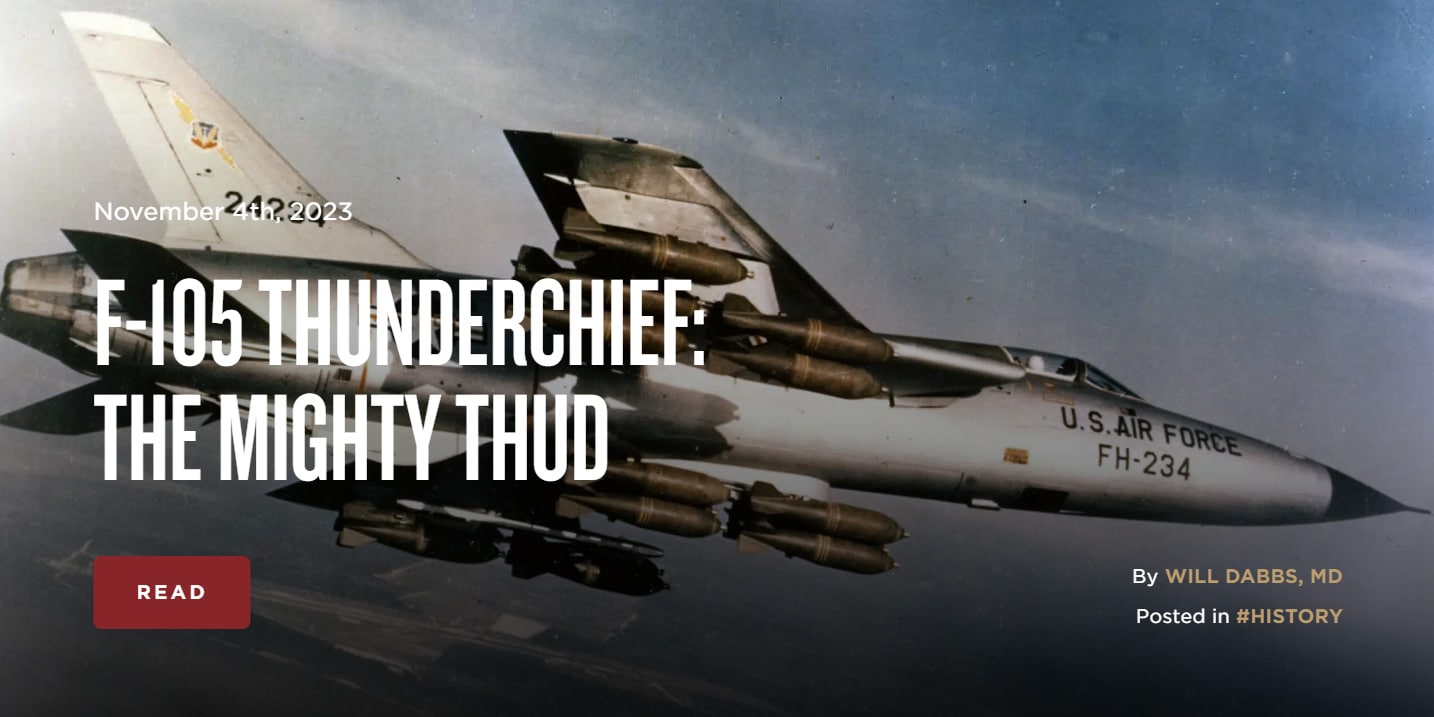Hello all, here is today's article posted on TheArmoryLife.com. It is titled “F-105 Thunderchief: The Mighty Thud” and can be found at https://www.thearmorylife.com/f-105-thunderchief/.



Operation Bolo, 1967. That's a legendary USAF operation. The full and complete story is told in Robin Olds' book Fighter Pilot. Highly recommended.They made good targets in Nam.Read the story on how we sent up a bunch of F4s looking like 105s and kicked the crap out of the Migs
Neither aircraft should have ever received an "F" designation, as they were not "fighters," they were, as you note, "all-weather attack aircraft." But the USAF was out of the A-for-Attack bidness as of 1947; their A-26 was redesignated B-26 as a "light bomber." (The USN was still in the A bidness at the time, with the North American A-5 Vigilante.)A few points.
1) The F-105 competed against the North American F-107A for USAF's requirement for an all-weather attack aircraft.
...
3) While the F-105 had an internal bomb bay, as a requirement to carry a nuclear bomb, during the Vietnam War, it was not utilized. Instead it was either locked shut, and/or had a 390 gallon fuel tank installed inside with a center-line hard point installed to carry ordnance externally.
A Fighter airplane is designed, built, and deployed primarily to fight other aircraft of some kind in some way. You can hang and haul bombs on one, of course, in which case it becomes a "fighter-bomber" (or, as the Germans called it, a "jabo"), but it's still designed to fight other aircraft, either offensively or defensively.They were multi-purpose fighter bombers just like the F-4 Phantom which dropped a lot of ordnance, so I guess according to your point-of-view the F-4 should have been the "A-4" Phantom?
And all subsequent "fighters" can/have the ability to attack targets on the ground.
A typical bomb load for the F-105D single seat Thunderchief in Vietnam was 16 750-lb. bombs mounted on five external hardpoints. In this configuration, the Thud was used to attack strategic targets like bridges and port facilities in North Vietnam.
Yeah, eject into the engine intake. That looks safe…A few points.
1) The F-105 competed against the North American F-107A for USAF's requirement for an all-weather attack aircraft.
2) In many aspects the F-107 had superior performance, but the F-105 was selected.
F-107
View attachment 46534View attachment 46537
USAF F-107A Ultra Sabre
www.airplanes-online.com
3) While the F-105 had an internal bomb bay, as a requirement to carry a nuclear bomb, during the Vietnam War, it was not utilized. Instead it was either locked shut, and/or had a 390 gallon fuel tank installed inside with a center-line hard point installed to carry ordnance externally.
4) The F-105 had several performance issues that weren't resolved until the development of the "D" model.
That's why this Keith Ferris painting (I've seen the real thing) is called Big Brass Ones.Their b@[[$ clanked when they walked...
Welcome home.I did a hitch in the Air Force ‘63-‘67, was in aircraft maintenance (instrument man), and worked on almost everything. My last duty station was Nellis AFB a couple of miles outside Las Vegas (and now basically a suburb in Vegas!). This was where 105 pilots were trained. F-4 and F-100 training was there also. I spent many hours working on them (reinstalling the instrument panel and working in the hell hole - a maintenance “access” hatch behind and below the cockpit were a b****h !). The instructor pilots were all Nam vets - and some of them had patches that said “100 missions North Viet Nam” with the fighter designation they had flown those missions in (F105, F4 or F100). The 105 guys had major bragging rights. The 104 was used in North Vietnam because it could deliver ordinance with pinpoint accuracy, but the approach was alway very low level - and the commies placed their targets next to/
Temples, hospitals, schools, etc.). That’s why so many were shot down.
One of the 105 IPs (instructors) was one of those, but he also told me that during the Cuban missile crisis in ‘62, the Air Force had tasked 105 squadrons with the mission of actually striking the missile sites, and had built wooden mockups of those sites in the mountains east of the base, oriented just like the real ones in Cuba. This IP said that they trained day and night for weeks to approach, strike and get away from them, and that the knockout mission would have only been about 30 minutes on station.
After my enlistment was up, I joined the Army to be a helicopter pilot, and flew in Nam with the First Cav.
Interesting times.
The F-107 ejection system was designed for that not to happen.Yeah, eject into the engine intake. That looks safe…
Certain items dont succeed for a reason.
North American Aviation, based in California, had several other Big $$$ Contracts going on at the time, IIRC, and Republic Aviation, based in Farmingdale, Long Island, NY, did not. Make of any of this what you will.The F-107 ejection system was designed for that not to happen.
Certain items are decided for political reasons.
The cancellation of the F-107 and F-108 programs in the late 1950s, as well as the cancellation of the Navaho intercontinental cruise missile program, was a blow to North American from which it never fully recovered.North American Aviation, based in California, had several other Big $$$ Contracts going on at the time, IIRC, and Republic Aviation, based in Farmingdale, Long Island, NY, did not. Make of any of this what you will.
